Jovian - Study guides, Class notes & Summaries
Looking for the best study guides, study notes and summaries about Jovian? On this page you'll find 102 study documents about Jovian.
Page 4 out of 102 results
Sort by
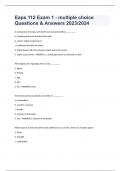
-
Eaps 112 Exam 1 - multiple choice Questions & Answers 2023/2024
- Exam (elaborations) • 28 pages • 2023
-
Available in package deal
-
- $10.49
- + learn more
Eaps 112 Exam 1 - multiple choice Questions & Answers 2023/2024 In comparison to today, early Earth was characterized by ________ . a. a landscape barren and devoid of color b. cooler, stable temperatures c. continents that did not move d. highly diverse life forms living on land and in the oceans e. stable ocean levels - ANSWER-a. a landscape barren and devoid of color The longest unit of geologic time is a(n) ________ . a. Epoch b. Period c. Age d. Eon e. Era - ANSWER-d. Eon ...
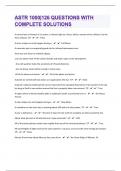
-
ASTR 1000|126 QUESTIONS WITH COMPLETE SOLUTIONS|2024
- Exam (elaborations) • 9 pages • 2024
-
- $7.99
- + learn more
A convex lens is thinnest in its center; it refracts light to a focus, while a convex mirror reflects it to the focus instead. T/F - ️️False A lunar eclipse can only happen during a: - ️️Full Moon A mountain top is an especially good site for infrared telescopes since: there you are closer to celestial objects. -you are above most of the carbon dioxide and water vapor in the atmosphere. -the cold weather helps the sensitivity of infrared detectors. -less air above means better se...
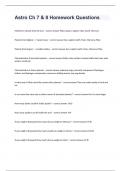
-
Astro Ch 7 & 8 Homework Questions with answers 2024
- Exam (elaborations) • 4 pages • 2024
- Available in package deal
-
- $9.99
- + learn more
Astro Ch 7 & 8 Homework QuestionsFarthest to closest from the Sun: - correct answer Pluto, Saturn, Jupiter, Mars, Earth, Mercury Planets from highest --> lowest mass: - correct answer Sun, Jupiter, Earth, Mars, Mercury, Pluto Planets from largest --> smallest radius: - correct answer Sun, Jupiter, Earth, Mars, Mercury, Pluto Characteristics of terrestrial planets: - correct answer Solid, rocky surface; located within the inner solar system; small size Characteristics of Jovian ...
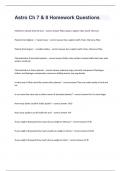
-
Astro Ch 7 & 8 Homework Questions well answers graded A+
- Exam (elaborations) • 4 pages • 2024
-
Available in package deal
-
- $9.99
- + learn more
Astro Ch 7 & 8 Homework QuestionsFarthest to closest from the Sun: - correct answer Pluto, Saturn, Jupiter, Mars, Earth, Mercury Planets from highest --> lowest mass: - correct answer Sun, Jupiter, Earth, Mars, Mercury, Pluto Planets from largest --> smallest radius: - correct answer Sun, Jupiter, Earth, Mars, Mercury, Pluto Characteristics of terrestrial planets: - correct answer Solid, rocky surface; located within the inner solar system; small size Characteristics of Jovian ...
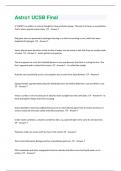
-
Astro1 UCSB Final Questions And Answers Rated A+ New Update Assured Satisfaction
- Exam (elaborations) • 6 pages • 2024
- Available in package deal
-
- $8.49
- + learn more
A THEORY is a pattern in nature thought to have predictive power. The test of a theory is a prediction. That's where pseudo-science fails. T/F - Answer-T Red giant stars are powered by hydrogen burning in a shell surrounding a core, which has been depleted of hydrogen. T/F - Answer-T Jovian planets have densities similar to that of water, and we know in fact that they are mostly made of water. T/F - Answer-F - Jovian planets are gaseous The Sun appears to circle the Celestial Sphere in on...
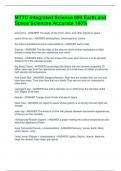
-
MTTC Integrated Science 094 Earth and Space Sciences Accurate 100%
- Exam (elaborations) • 7 pages • 2024
-
Available in package deal
-
- $10.99
- + learn more
astronomy - ANSWER The study of the moon, stars, and other objects in space layers of the sun - ANSWER photosphere, chromosphere, corona the moons gravitational pull is responsible for - ANSWER earths tides Equinox - ANSWER The two days of the year on which neither hemisphere is tilted toward or away from the sun; september and march Solstice - ANSWER Either of the two times of the year when the sun is at its greatest distance from the celestial equator Big Bang Theory - ANSWER (c...

-
Astro Ch 7 & 8 Homework Questions and answers 2024 verified to pass
- Exam (elaborations) • 4 pages • 2024
-
Available in package deal
-
- $13.49
- + learn more
Astro Ch 7 & 8 Homework Questions and answers 2024 verified to passAstro Ch 7 & 8 Homework Questions Farthest to closest from the Sun: - correct answer Pluto, Saturn, Jupiter, Mars, Earth, Mercury Planets from highest --> lowest mass: - correct answer Sun, Jupiter, Earth, Mars, Mercury, Pluto Planets from largest --> smallest radius: - correct answer Sun, Jupiter, Earth, Mars, Mercury, Pluto Characteristics of terrestrial planets: - correct answer Solid, rocky surface; locat...
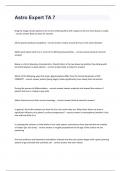
-
Astro Expert TA 7 Question and answers 100% correct 2024
- Exam (elaborations) • 3 pages • 2024
-
Available in package deal
-
- $13.99
- + learn more
Astro Expert TA 7 Question and answers 100% correct 2024 Astro Expert TA 7 Drag the image of each planet to its correct orbital position with respect to the Sun (not drawn to scale). - correct answer (look at notes for answer) All the planets (without exception) - correct answer revolve around the Sun in the same direction Match each planet with one or more of its defining characteristics. - correct answer (look at notes for answer) Below is a list of planetary characteristics. Cl...
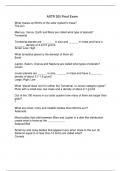
-
ASTR 205 Final Exam
- Exam (elaborations) • 7 pages • 2023
-
Available in package deal
-
- $10.00
- + learn more
What makes up 99.8% of the solar system's mass? The sun Mercury, Venus, Earth and Mars are called what type of planets? Terrestrial Terrestrial planets are ________ in size and ______ in mass and have a _______ density of 3.9-5.5 g/cm3 Small; Low; High What terrestrial planet is the densest of them all. Earth Jupiter, Saturn, Uranus and Neptune are called what types of planets? Jovian Jovian planets are ______ is size, ______ in mass and have a _______ density of about 0.7-1...
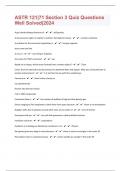
-
ASTR 121|71 Section 3 Quiz Questions Well Solved|2024
- Exam (elaborations) • 4 pages • 2024
- Available in package deal
-
- $8.49
- + learn more
A gas cloud collapses because of - ️️self-gravity A low pressure region in Jupiter's southern hemisphere moves - ️️counter-clockwise A problem for the encounter hypothesis is - ️️hot gas expands stars move too fast A virus is - ️️non-living in isolation Are moon for TNO's common? - ️️yes Based on its shape, which moon formed from a molten object? - ️️Titan Ceres, the first asteroid to be discovered, lies between Mars and Jupiter. Why was Ceresunknown to ancient a...

Do you wonder why so many students wear nice clothes, have money to spare and enjoy tons of free time? Well, they sell on Stuvia! Imagine your study notes being downloaded a dozen times for $15 each. Every. Single. Day. Discover all about earning on Stuvia


